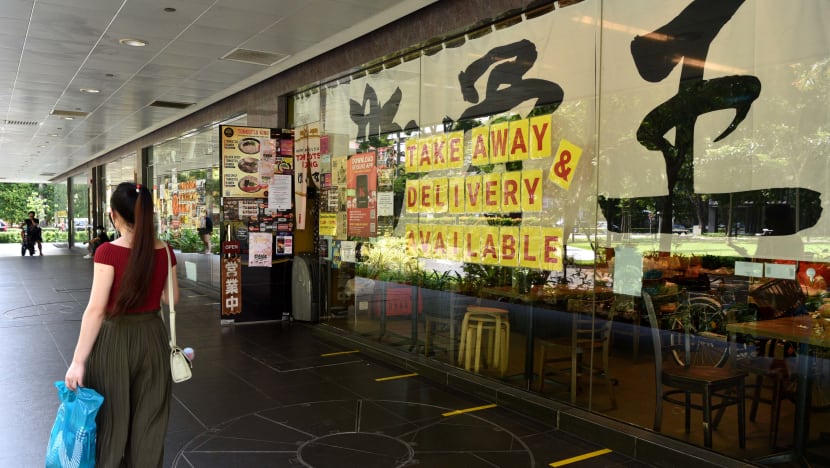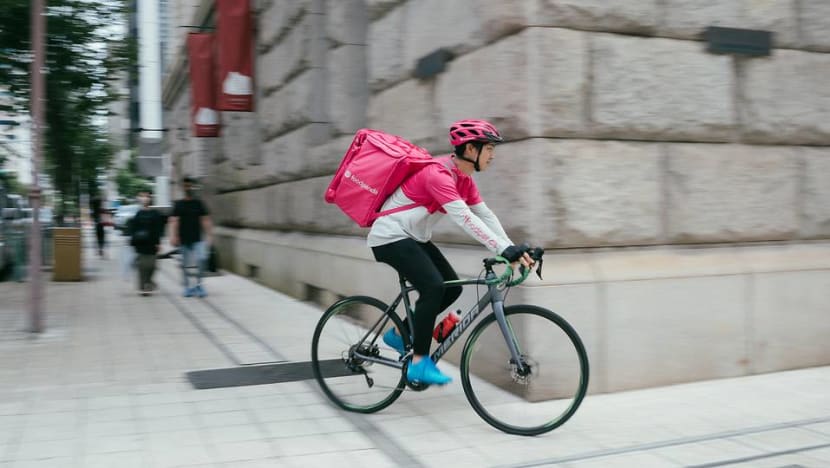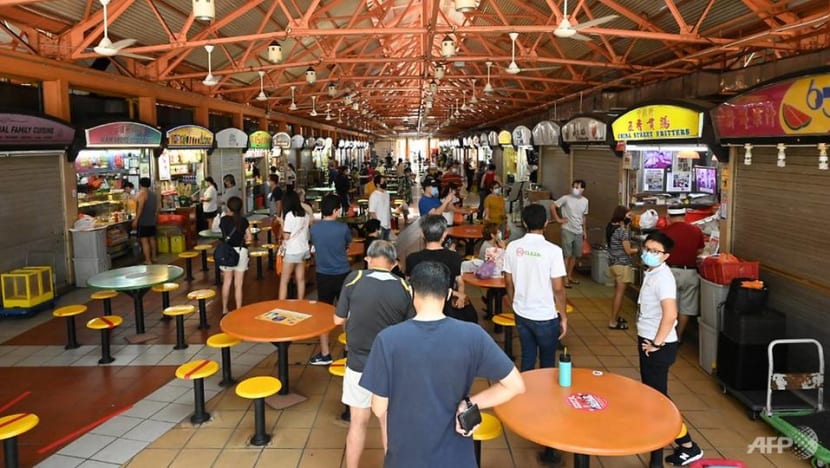Commentary: Can the F&B industry and food delivery platforms cope better this time around?
With no chance for dining in for the next few weeks, more Singaporeans will turn to ordering their food online. But have the knots in delays and lack of service been sorted out for round two, asks an NUS Business School professor.

In-dining has been put on hold in Singapore as part of stricter measures to manage a new wave of COVID-19 cases in Singapore. (Photo: Jeremy Long)
SINGAPORE: My friends and I were planning to go to a Lebanese restaurant in Singapore on a Tuesday night.
With the announcement of new heightened measures to fight COVID-19, including no dine-ins and a maximum party size of two (from different households), the dinner wasn’t possible.
Like the Lebanese restaurant, many other F&B businesses in Singapore will be swiftly adjusting their delivery operations. With prior experience during the circuit breaker in 2020, can these businesses feed their customers in time, and feed their workers over time?
READ: No dining-in at eateries: Restaurants pivot again, food delivery services gear up
There were some tough lessons last year.
Many of the smaller outlets had no previous experience with delivery or for that matter, anything digital. As a result, many just either appealed for orders on Facebook and asked people to call them or just posted a non-digital friendly PDF of their menu.
A number of providers like WhyQ, SG Dabao and Hawkers United have emerged to help the smaller players, but challenges still remain, especially when it comes to delivering items quickly.
When demand spikes and orders are not delivered in time, hungry customers will become angry customers. Last year’s Mother’s Day was a good example, when people had to wait for a long time for their orders.
Beyond increasing the number of kitchen staff, restaurants are bound by the number of delivery drivers too, some of whom come from third-party fleets.
Third-party fleets are not necessarily set up to handle food orders and may not have the same level of logistics support - for instance, order tracking or location tracking - as the major delivery providers and so this limits how much they can do too.
ORDERING EARLY CAN MAKE A DIFFERENCE
The unexpected knight to the rescue here is actually the customer but it requires them to plan what they want to eat in advance. Because when they order ahead of time – say during off-peak hours, restaurants can deliver these promptly.
The trouble is, like dine-in, peak meal times also mean that the kitchen can become over loaded. This not only means the customer has to wait – sometimes up to two hours – but the food delivery staff cannot pick up other orders since he has committed to this order.
It is true that most people only order right before they want to eat. But if ordering in advance helps you get your food more promptly, why not?
READ: Food outlets, retailers to get help with delivery costs, going online with reintroduced schemes
And food delivery platforms already have this function – for instance, after you have picked the food option you want, you can select the “Deliver Now” or “Schedule” which includes a drop down for date and time.
In my experience talking to restaurants, getting orders ahead of time is helpful because it allows them to better plan their production. And food delivery riders can also be appropriately deployed throughout the day.

Customers can also opt for contactless delivery, this option is available on all the major delivery platforms. This is not just safer for those involved, it also speeds things up for the hardworking delivery driver.
As rides are made and meals are delivered, F&B businesses see an increasing proportion of revenue coming from their online business.
Before the circuit breaker in 2020, online business accounted for about 10 per cent of F&B revenue in Singapore. My own studies showed that about half of the customers were ordering delivery at least once a week. This is mostly due to customers’ penchant for convenience.
After the circuit breaker, online business accounted for about 20 per cent of F&B revenue. In March 2021, this percentage had risen to 23.5 per cent, according to the F&B Services Index published by SingStat.
This figure also shows that the majority of sales come from dine-ins or physical shops. Hence, while the new heightened measures are not as strict as those implemented during the circuit breaker, they still affect the business to some extent because the majority of a restaurant's business comes from dine-ins.
FUNDING AND MINDSET SHIFT WILL HELP
Enterprise Singapore has stepped in to help, with packages that subsidise partial delivery costs and extend the businesses’ reach online.
In general, restaurants pay a substantial commission (20 to 30 per cent) for orders placed through the major delivery platforms (Deliveroo, foodpanda and Grab). Some of the other delivery providers and logistics companies charge lower fees, but the cost to the restaurant is still substantial.
READ: Commentary: Food delivery apps are meant to make our lives easier, not worse
The ESG funding will reduce the commission fee to the food delivery platforms by five percentage points - that is, if the original commission fee is 30 per cent of the order price, the restaurant now only needs to pay 25 per cent.
This support, which will last until Jun 15, can help to some extent.

The Restaurant Association of Singapore and the Singapore Nightlife Business Association have also posted open letters on their Facebook pages, asking for rental support from landlords and commission support from food delivery partners. Time will tell whether this support will be sufficient.
What F&B businesses can do now is to recognise that the pandemic is not going to go away just because they wish it that way. When dine-in came back, businesses thought they were done with delivery and so beefing up their online delivery capabilities became an after-thought.
Happy to just serve customers who came through their doors, some of them didn’t see the need to ramp up and improve their digital presence. Many of these haven’t changed their production model to account for delivery (this includes online tracking). Their social media presence hasn’t changed much either.
The savvier operators on the other hand make going digital a priority and update their social media on a daily basis – using pictures and daily specials with contact details for ordering via their site or through WhatsApp. So when dine-in stops suddenly, they can switch seamlessly.
PUT IN PLACE BEST PRACTICES
Besides a mindset shift and technology assistance, F&B businesses can take a leaf from the best practices around.
What can they do? First, restaurants can promote takeaway over delivery. Takeaway orders are more profitable because its commission cost is lower.
A discounted takeaway price to attract customers will still be more worth it than having to pay the delivery commission. For example, during the circuit breaker, TungLok Seafood Takeaway Bento offered 20 per cent lower prices for self-collection and foodpanda offered a 15 per cent to 20 per cent discount for takeaway orders.
READ: Commentary: We are becoming a 'dabao nation' – why does it feel like a bad thing?
Second, think about the menu. Deliveroo, foodpanda and Grab all give restaurant operators some flexibility in how their menu items are written and presented. The operators can consider limiting the number of items on their delivery menu.
This makes it easier for customers to make a selection. In terms of menu items, they should also choose the best sellers as well as high profit margin items that travel and reheat well.
In addition, research by US online food ordering company DoorDash has shown that good photos and compelling descriptions make a difference. More food customisation options are also able to drive more orders.
Third, think about the customers. Many of them are probably ordering for their families. Design your menu with this in mind. Consider offering family packages and bundles. If a substantial percentage of your customers are families, be sure to offer “kid-friendly” food options.
The delivery game is one that F&B businesses need to master in order to stay ahead. In games and in the real world, we get dealt different cards. Nobody likes the cards on the pandemic, or when you have high demand but not enough capability to fulfill the orders.
But leveraging prior lessons, planning ahead and putting in place best practices can help in tiding over the crisis. I very much look forward to the day when I can enjoy a dinner with my friends at an onsite restaurant again.
Sherri Kimes is a Visiting Professor of Analytics & Operations at the National University of Singapore Business School. The opinions expressed are those of the writer and do not represent the views and opinions of NUS.
One year since the pandemic, why do users, riders and restaurants alike still have complaints about food delivery apps? A business professor and a ride-hailing app founder weigh in on CNA's Heart of the Matter podcast:












